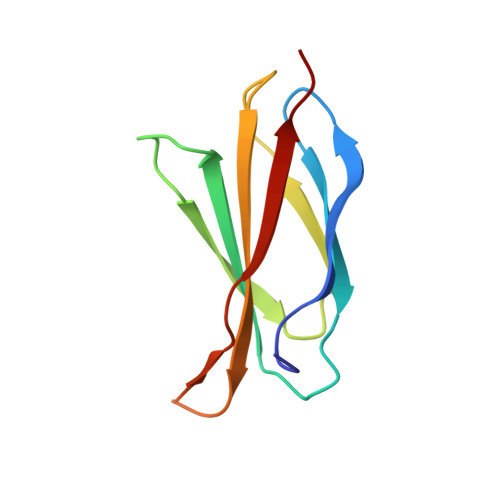Designing an Extracellular Matrix Protein with Enhanced Mechanical Stability
Ng, S.P., Billings, K.S., Ohashi, T., Allen, M.D., Best, R.B., Randles, L.G., Erickson, H.P., Clarke, J.(2007) Proc Natl Acad Sci U S A 104: 9633
- PubMed: 17535921
- DOI: https://doi.org/10.1073/pnas.0609901104
- Primary Citation of Related Structures:
2CK2 - PubMed Abstract:
The extracellular matrix proteins tenascin and fibronectin experience significant mechanical forces in vivo. Both contain a number of tandem repeating homologous fibronectin type III (fnIII) domains, and atomic force microscopy experiments have demonstrated that the mechanical strength of these domains can vary significantly. Previous work has shown that mutations in the core of an fnIII domain from human tenascin (TNfn3) reduce the unfolding force of that domain significantly: The composition of the core is apparently crucial to the mechanical stability of these proteins. Based on these results, we have used rational redesign to increase the mechanical stability of the 10th fnIII domain of human fibronectin, FNfn10, which is directly involved in integrin binding. The hydrophobic core of FNfn10 was replaced with that of the homologous, mechanically stronger TNfn3 domain. Despite the extensive substitution, FNoTNc retains both the three-dimensional structure and the cell adhesion activity of FNfn10. Atomic force microscopy experiments reveal that the unfolding forces of the engineered protein FNoTNc increase by approximately 20% to match those of TNfn3. Thus, we have specifically designed a protein with increased mechanical stability. Our results demonstrate that core engineering can be used to change the mechanical strength of proteins while retaining functional surface interactions.
Organizational Affiliation:
Cambridge University Chemical Laboratory, Medical Research Council Centre for Protein Engineering, Lensfield Road, Cambridge CB2 1EW, United Kingdom.















